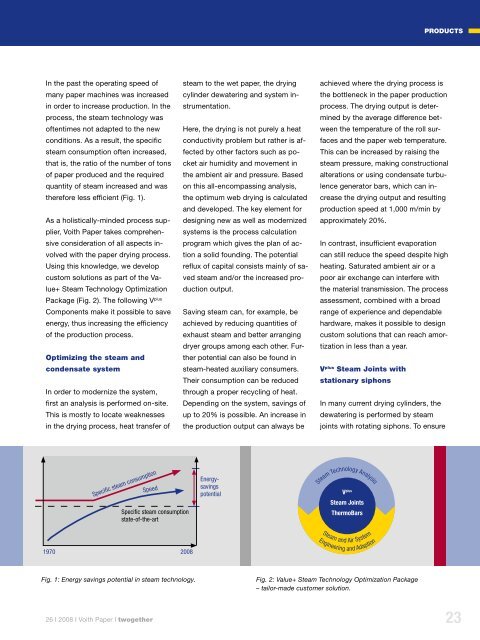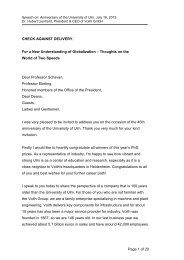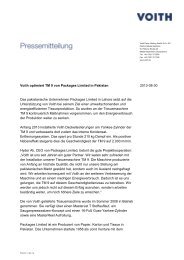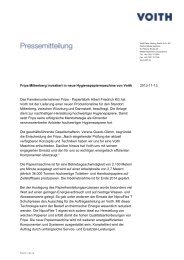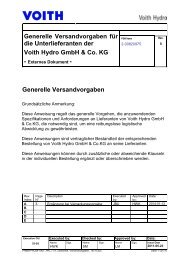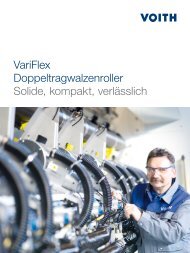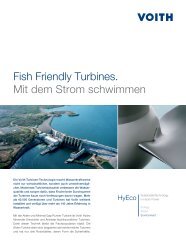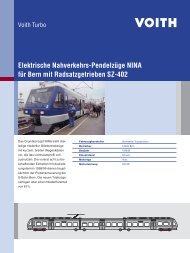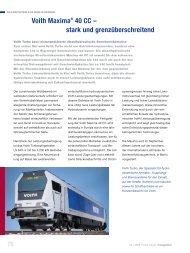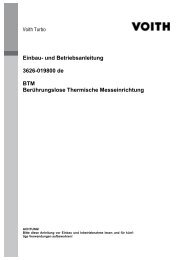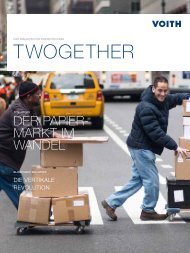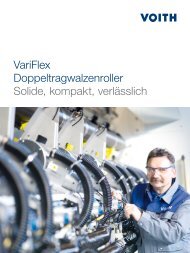2 Water for life requires inventiveness I Daio Paper Mishima ... - Voith
2 Water for life requires inventiveness I Daio Paper Mishima ... - Voith
2 Water for life requires inventiveness I Daio Paper Mishima ... - Voith
Create successful ePaper yourself
Turn your PDF publications into a flip-book with our unique Google optimized e-Paper software.
In the past the operating speed of<br />
many paper machines was increased<br />
in order to increase production. In the<br />
process, the steam technology was<br />
oftentimes not adapted to the new<br />
conditions. As a result, the specific<br />
steam consumption often increased,<br />
that is, the ratio of the number of tons<br />
of paper produced and the required<br />
quantity of steam increased and was<br />
there<strong>for</strong>e less efficient (Fig. 1).<br />
As a holistically-minded process supplier,<br />
<strong>Voith</strong> <strong>Paper</strong> takes comprehensive<br />
consideration of all aspects involved<br />
with the paper drying process.<br />
Using this knowledge, we develop<br />
custom solutions as part of the Value+<br />
Steam Technology Optimization<br />
Package (Fig. 2). The following Vplus Components make it possible to save<br />
energy, thus increasing the efficiency<br />
of the production process.<br />
optimizing the steam and<br />
condensate system<br />
In order to modernize the system,<br />
first an analysis is per<strong>for</strong>med on-site.<br />
This is mostly to locate weaknesses<br />
in the drying process, heat transfer of<br />
Specific steam consumption<br />
1970 2008<br />
26 I 2008 I <strong>Voith</strong> <strong>Paper</strong> I twogether<br />
steam to the wet paper, the drying<br />
cylinder dewatering and system instrumentation.<br />
Here, the drying is not purely a heat<br />
conductivity problem but rather is affected<br />
by other factors such as pocket<br />
air humidity and movement in<br />
the ambient air and pressure. Based<br />
on this all-encompassing analysis,<br />
the optimum web drying is calculated<br />
and developed. The key element <strong>for</strong><br />
designing new as well as modernized<br />
systems is the process calculation<br />
program which gives the plan of action<br />
a solid founding. The potential<br />
reflux of capital consists mainly of saved<br />
steam and/or the increased production<br />
output.<br />
Saving steam can, <strong>for</strong> example, be<br />
achieved by reducing quantities of<br />
exhaust steam and better arranging<br />
dryer groups among each other. Further<br />
potential can also be found in<br />
steam-heated auxiliary consumers.<br />
Their consumption can be reduced<br />
through a proper recycling of heat.<br />
Depending on the system, savings of<br />
up to 20% is possible. An increase in<br />
the production output can always be<br />
SpeedEnergysavings<br />
potential<br />
Specific steam consumption<br />
state-of-the-art<br />
Fig. 1: Energy savings potential in steam technology.<br />
achieved where the drying process is<br />
the bottleneck in the paper production<br />
process. The drying output is determined<br />
by the average difference between<br />
the temperature of the roll surfaces<br />
and the paper web temperature.<br />
This can be increased by raising the<br />
steam pressure, making constructional<br />
alterations or using condensate turbulence<br />
generator bars, which can increase<br />
the drying output and resulting<br />
production speed at 1,000 m/min by<br />
approximately 20%.<br />
In contrast, insufficient evaporation<br />
can still reduce the speed despite high<br />
heating. Saturated ambient air or a<br />
poor air exchange can interfere with<br />
the material transmission. The process<br />
assessment, combined with a broad<br />
range of experience and dependable<br />
hardware, makes it possible to design<br />
custom solutions that can reach amortization<br />
in less than a year.<br />
V plus steam Joints with<br />
stationary siphons<br />
In many current drying cylinders, the<br />
dewatering is per<strong>for</strong>med by steam<br />
joints with rotating siphons. To ensure<br />
Steam Technology Analysis<br />
V plus<br />
Steam Joints<br />
ThermoBars<br />
Steam and Air System<br />
Engineering and Adaption<br />
Fig. 2: Value+ Steam Technology Optimization Package<br />
– tailor-made customer solution.<br />
PRoDUCTs<br />
23


